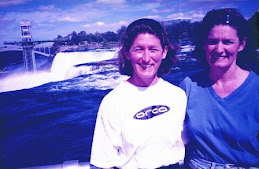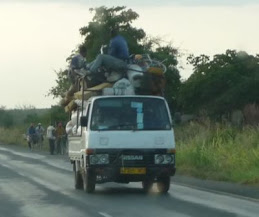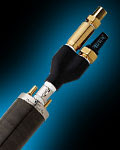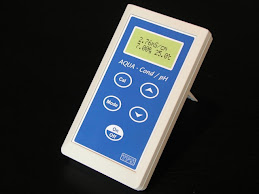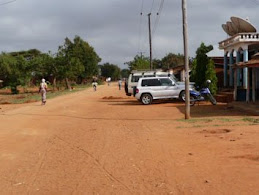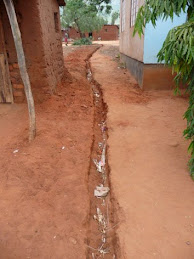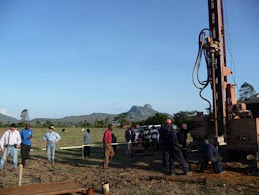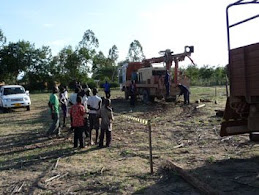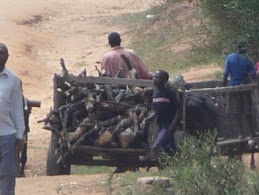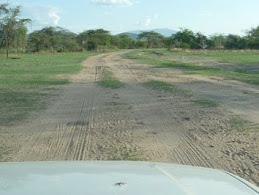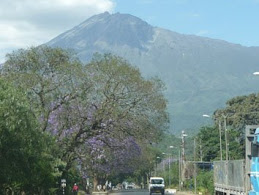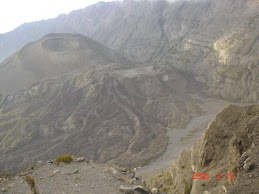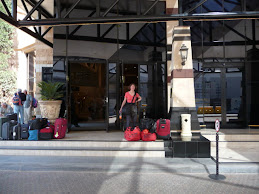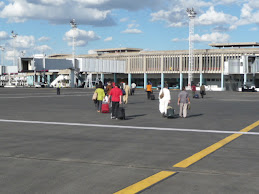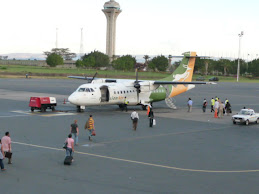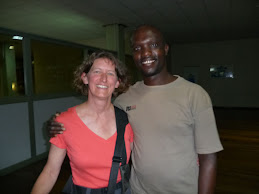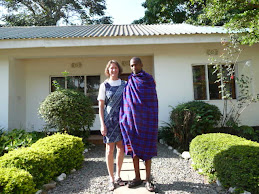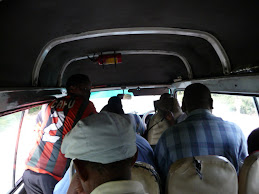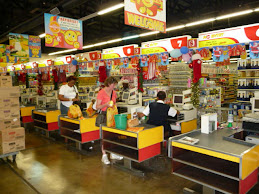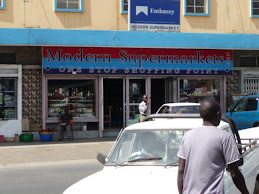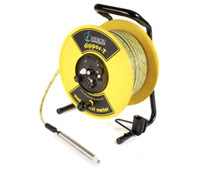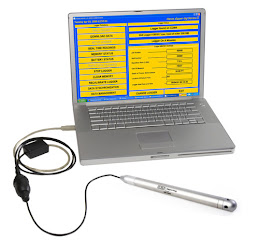This is a bit amusing now but yesterday not so much. The kitchen we have in this temp house has a gas stove on one side and the electrical power point on the other side. We only moved into this house on Tues nite and had been fixing it up to make it work somewhat half decent at least. Some Leaking taps, some power outlets not working, some lights not working, no hot water. We bought a power strip to put in the kitchen to run the fridge and also bought a kettle and toaster. Ramona went to cook some noodles yesterday on the stove. She is scared to light these gas burners as the go woof some times. We have a little sparker we bought to light the burner as matches are too tricky. So I lit the big element on the stove and then went to light one of the other smaller ones. ½ way through that a large flame came out of the top of the stove and a large WOOF sound. The flame only lasted milli seconds but was long enough to singe the hairs on my arms. Ramona yelped and leaped back as did I. I turned the elements off and waited till our heart beats got back under control then tried the big element again. It lit then again after about 20 secs, another woof and a small flame this time came out the side. So we just turned it off again quickly. Ramona was still backed up against the other wall with her heart rate back up. Then about 1 min later the power strip we had bought which was now just behind Ramona blew up with a loud bang. This freaked her out even more as she didn’t know whether to run away from that towards the stove or run back to the power strip not knowing what was going on there at all. So making sure the stove was off and the power was off we tried to catch our breaths now and see what was going on.
Investigations showed the problem with the power strip was I had coiled up the spare lead then tied it up with a cable tie I got from a loaf of bread. This is really a no no as coiled electrical cables can cause induction heating of themselves. Where I had tied the coils together, the flex wire was melted, it had shorted out.
Next the stove. Ben the other Aust volunteer who is staying with us for the next 6-7 weeks, and I lifted the top of the stove up and examined the pipes coming from the gas bottle into the stove then spreading out, one pipe to each of the 4 burners. Sure enough that big burner had a loose nut. So what had been happening was when that burner was turned on, some gas was coming out under the top plate of the stove and filling the 4” deep cavity under that. Then once the cavity was full and the gas reached the flames on top, woof! We tightened up that nut real good like then Ben and I took turns at lighting an element then running out of the room to wait a minute or two. It all works good now.
But dang we probably aged several years in that 2-3 minutes. Ramona refuses to have anything to do with lighting the stove burners now. Can’t say I blame her.
Saturday, January 10, 2009
House in Gairo for the Water Project
We are now staying in this brick-plaster house by the ADRA office, completely surrounded by sand and dirt, a couple of trees around but not much else apart from the chickens. This makes it dusty when the wind blows. We mopped all the floors the first day as it has not been lived in for quite a while we think and there was a build up. But is a much better than the little guesthouse room we were in the two weeks before Christmas. The ADRA temporary Gairo office is literally right across the road about 20 meters away. There are mud brick house with thatched or tin rooves beside us. There are lots of little kids around and they sit in the dirt for hours playing or looking at the house waiting to see the mzungus come out. When you walk outside sometimes you hear Mzungu! Mzungu! and you look around a see a kid somewhere waving at you. They are quite cute. All the neighbours seem real friendly and polite. There is no trash removal service as you can imagine. The office security guard dug a hole in the back yard dirt to burn trash in. The first lot we put in there the kids came and took most of it away. But they always seem to be smiling and laughing at us.
When we came to the house the first night from Dar, Ben another Australian volunteer who has joined us in Gairo for a couple of months (but also stayed in the house over the Christmas break) said there was no running water working, 1/2 of the taps leaked when we did get some water, the toilet acted like a sprinkler, some light fixtures were missing, some of the wall power sockets didn’t work. Hence these last 5 days have been a domestic challenge. Jacob with ADRA here has been very good at getting things fixed up. He goes to find the various fundi’s (tradesmen) around town to come to the house to fix something else if we can’t. It sort of worked out well, as we had expected the drillers to come back and start work on the 5th Jan but they got delayed a week, due to full busses and the difficulty setting up accounts here for the drillers to buy fuel on account as they use a lot of it. This week’s delay allowed us to get the house sorted out and to help write an overdue annual report for the Danish embassy on the projects progress to date. As once the drillers start, we will all be out in the field 10 hrs a day and nothing else would have happened. At least now we have the house set up, and are using it as our office with the computers, printer and internet set up. Things here get fixed using the absolute lowest cost way(free if they can find materials lying on the ground that may do the job). So it all seems a bit dodgy and will it last the few months we are to be here is a good question. Gairo has no domestic running water into any houses (except ours now since we are mzungus) so there are no plumbers here. So to get any plumbing done is to use a guy who mainly uses a hammer and a coal chisel. Hot water still seems to be an elusive thing in our African adventure today except in the Dar hotels. The electrician turned up on foot with a screw driver in his pocket.
We had a local carpenter make us a table so we could set our computers up on it to have some ordered working space. A bit of a relief! (We are going to give the table to Jacob, the water engineer, when we move on so he can use it.) The carpenter’s shop is a walled in dirt yard with a few electric saws and planers under a lean-to. Nice guy who speaks good English. Today he walked around to tell us the table was ready but he couldn't varnish in his yard due to the dust so he came to varnish it in the house today. He then hired a couple of guys with a wooden cart to bring the table around to us. It is about a mile away on dirt roads.
For water we are fortunate to have a water tank on the roof. A few days a week a line gets turned on to let water flow to the house. Jacob installed a little booster pump to lift the water up to the tank. We can’t see how full the tank is, so for the first time we got up on the roof and saw how full the tank was and then measured the flow rate from the pump using a std bucket and then calculating how long it would take to fill the remaining part of the tank. We left it to run a little too long I guess and the tank over flowed on to the flat roof and started to run off the roof out through over flow pipes. Ramona had a bucket outside trying to catch the water and then other woman saw what the muzungu mama was doing so they all bought buckets too to catch as much water as they could. It is so precious they can’t waste any of it. One little boy scooped the water out of a little hole in the dirt and put it in a bucket.
When we came to the house the first night from Dar, Ben another Australian volunteer who has joined us in Gairo for a couple of months (but also stayed in the house over the Christmas break) said there was no running water working, 1/2 of the taps leaked when we did get some water, the toilet acted like a sprinkler, some light fixtures were missing, some of the wall power sockets didn’t work. Hence these last 5 days have been a domestic challenge. Jacob with ADRA here has been very good at getting things fixed up. He goes to find the various fundi’s (tradesmen) around town to come to the house to fix something else if we can’t. It sort of worked out well, as we had expected the drillers to come back and start work on the 5th Jan but they got delayed a week, due to full busses and the difficulty setting up accounts here for the drillers to buy fuel on account as they use a lot of it. This week’s delay allowed us to get the house sorted out and to help write an overdue annual report for the Danish embassy on the projects progress to date. As once the drillers start, we will all be out in the field 10 hrs a day and nothing else would have happened. At least now we have the house set up, and are using it as our office with the computers, printer and internet set up. Things here get fixed using the absolute lowest cost way(free if they can find materials lying on the ground that may do the job). So it all seems a bit dodgy and will it last the few months we are to be here is a good question. Gairo has no domestic running water into any houses (except ours now since we are mzungus) so there are no plumbers here. So to get any plumbing done is to use a guy who mainly uses a hammer and a coal chisel. Hot water still seems to be an elusive thing in our African adventure today except in the Dar hotels. The electrician turned up on foot with a screw driver in his pocket.
We had a local carpenter make us a table so we could set our computers up on it to have some ordered working space. A bit of a relief! (We are going to give the table to Jacob, the water engineer, when we move on so he can use it.) The carpenter’s shop is a walled in dirt yard with a few electric saws and planers under a lean-to. Nice guy who speaks good English. Today he walked around to tell us the table was ready but he couldn't varnish in his yard due to the dust so he came to varnish it in the house today. He then hired a couple of guys with a wooden cart to bring the table around to us. It is about a mile away on dirt roads.
For water we are fortunate to have a water tank on the roof. A few days a week a line gets turned on to let water flow to the house. Jacob installed a little booster pump to lift the water up to the tank. We can’t see how full the tank is, so for the first time we got up on the roof and saw how full the tank was and then measured the flow rate from the pump using a std bucket and then calculating how long it would take to fill the remaining part of the tank. We left it to run a little too long I guess and the tank over flowed on to the flat roof and started to run off the roof out through over flow pipes. Ramona had a bucket outside trying to catch the water and then other woman saw what the muzungu mama was doing so they all bought buckets too to catch as much water as they could. It is so precious they can’t waste any of it. One little boy scooped the water out of a little hole in the dirt and put it in a bucket.
Christmas 08 Trip to Kilwa
After the Selous, we went on to Kilwa. Kilwa is a tiny little town on the south east coast centered on one bay about ½ mile across. Three little motels surround the bay. We stayed at the north end one which was on a cliff overlooking the ocean. Like the tropics the buildings are simply a roof with no walls as it is always warm there. The rooms were a set of thatched roof A frame units. No hot water. Power on and off. But they have a generator if needed to light up a few lights. It is quite nice to sit in a warm ocean wind drinking a cold beer in the dark, but trying to sleep in the heat/humidity with no breeze nor air conditioning (not existent) nor ceiling fan (electricity was off!) The bar and dining tables were just one bigger room with a big baobab tree growing up through the center to support the thatched roof at the center. Bob Marley was going in the back ground. Only a couple of other folks there. Nice and simple but quite a nice place once there. Mzungus would be most of the business there it seems. As usual it was off the main road and no signs how to get to it or one half fallen down one. So you have to drive thru this set of local houses and streets to get to it hoping it is the right way. They just don’t get the power of marketing over here.
We got talking to 3 young guys from South Africa in a land cruiser also staying at the motel. They were on a heck of a trip between university years. The bought the landy to go on this 3 month trip. They left Jo’burg and are driving up the east coast of Mozambique, Tanzania and Kenya then crossing over to the west side of Kenya and coming back down through the rift valley and along the big lakes there, back thru Victoria falls into Zambia, then Botswana to S Africa again. Kilwa was their first stop in Tanzania coming out of Mozambique that morning. Kilwa is about 300 km from the border. Their trip through Mozambique was somewhat hair raising with high water levels across roads, no maps of many roads, they don’t speak Portuguese, they ran out of cash and the ATMs didn’t work. Sounds like in Northern Mozambique there are no roads anyway just trails through the scrub, the villagers are educated so poorly (as they are in TZ in places) they can’t read maps and don’t even understand the concept of a map, so these guys had a heck of time trying to get to the border crossing town. The Moz to TZ border is a wide river. There is meant to be a bridge, but it is gone, there is meant to be a ferry but it sank. So here they were enough gas for 200 km and about $300. The last gas place was about 200 km back in to Mozambique. They struck a deal with the local fishermen to make a raft by lashing three fishing boats together, put the cruiser on top of that and rowing across the river for $250. They thought Tz was a modern relief to enter after Mozambique!
For some unknown obvious reason the road down the SE cost of TZ is actually sealed once you are south of Kilwa. One of the past major politicians came from one of the town in the south so maybe that was the reason. The roads were made by the Japanese and were the best we had seen so far. So once at Kilwa we thought now that we are past that danged rough road and are on tarmac we might as well see the area more as we are unlikely to come this far south again and face that rough road again. So we went further down the coast from Kilwa to Linde then Mtwara near the Mozambique border as the South African guys had said the road was good all the way.
Kilwa is known as an old center of trade back in the 1500s under the Arab traders and sultans had built palaces and houses in the area. Then later the Portuguese had come and taken over and remodeled some of the buildings or built new ones. They are all mostly ruins now but a fascinating place to go explore to see these old structures. A couple had been restored by donors over the recent years. The best ruins are on an island off the shore about 2 miles. The island is called Kilwa Kisiwani. From Kilwa beach we caught a dhow sailing boat off the beach over to the island. We went with the other couple staying at the motel with us, an English couple who worked at the British High Commission, with their two teenage sons. We all went on the same tour of the island so got to chat with them quite a bit during the day. Nice couple with an interesting career. They get posted to various places around the world in various High commission offices for 3-4 years at a time. They moved in quite high circles in Tz, so knew most of the politicians, what TZ politics was doing and likes. It was quite interesting to talk with them.
The dhow is an interesting boat. It has a center mast but no sail attaches to it. The sail is triangular shape and the long side is tied to a long pole. If the dhow is going down wind this long pole is pulled up horizontally to the top of the mast with the sail below it, so it acts like a spinnaker and billows out to catch the wind. If the dhow has to sail up wind, the long pole is tied vertical against the mast pole to make a conventional shape sale so it can tack back and forth. There is only one pulley on the boat which is used to move the sail pole relative to the mast pole. No cleats either. All hand tied. Quite crude but it works and they sail all over the place there fishing and hauling stuff back and forth. We spent about 4 hours on the Island on the tour of the ruins. Must have taken over 100 pictures. There is one village of locals there where we stopped to get a coke as it was quite hot. There was a nearby water well with ladies dropping buckets about 30 ft down it to get water. Not 20 yards away was a hand pump over a bore that some NGO had installed fairly recently (with in 2 yrs) it looked like. There were kids there using it to pump water into plastic buckets. It is a lot easier and faster to get water from a hand pump then from a bucket down a well that may be polluted as well. So I asked the guide why the women still used the well and not the hand pump. He replied in a broken English manner that the hand pump water was salty so they could only use it to wash in, not for consumption, hence the need for the water well too! I wonder if the NGO knew this? Oh well, good intentions I expect. Made me thankful we had gotten a salinity meter for testing our wells.
After the ruins we went back on the dhow to the Kilwa beach and went to one of the other motels which was right on the beach for lunch with the English family. Downed two sodas in about 15 mins it was so hot. After lunch we were walking back along the beach to our motel and one of the fishing dhows had just beached and was cutting up a shark they had caught that morning. The English guy buys a big steak off them for $6 and takes it back to our motel and asked them to cook it up for them that night.
The next day we headed south down past a town called Linde then on to the last southern town before the Mozambique border called Mtwara. Another small fishing town really. The English family were headed down there too but stopping at a little town called Mikindani about 10 km short of Mtwara. There was a restored German Boma (Old administration building the Germans had built during their occupation of Tz in the first world war.) Now it was a beautiful old building on the side of a hill in amongst this set of typical TZ buildings making the rest of the town. We stopped there for lunch as it seemed quite nice. While there the English family showed up to check in as they were staying there. They said we should too. But we didn’t want to overstay our welcome with them, so we decided to go on to Mtwara. This is an interesting little town. Sort of on a peninsula so unlike Kilwa which was a few buildings along a small dirt road, Mtwara is more spread out all over the peninsula. We had made a reservation that morning based on a recommendation in the Lonely Planet. We found it on a dirt road on the ocean front. It too was basic but amazing it is right on the water, about 10 yards off the waves. Blue and turquoise waters across the bay to another peninsula. Dhows sailing back and forth in the afternoon winds made it very picturesque. A big open air dining/bar area. Like Kilwa though there are just not many tourists there. Had it been in the western world it would have been packed. We met and chatted to a few other Mzungus on the beach staying in the budget guest houses nearby. One was from Switzerland doing an electricians job way out west in the middle of nowhere it seemed. Then we met a girl from the Peace Corps and her boyfriend who had just flown in to spend time with her. She was quite young and doing some hard yards but seemed to be enjoying it. She was assigned to the same town as the Swiss guy turned out. She had no power, no water, had to fetch her own in buckets, cook over an open fire, dirt floor I would think, no transport other than a bus. Ramona and I both cringed.
The guide book said there was a store called Safina where you could buy a few nibbles like candy, biscuits and juice etc. We turned in to the road but could see no shop, it was like a drive way. Then backing up we realized the shop was old 20ft container with this old Dutch woman sitting outside of it. We went in there and sure enough there were the nibbles. She had been in Mtwara a long time she said. The next day as we drove down the main street of the town we realized almost all of the shops were old 20ft containers side by side with a bit of wooden front structure built around it. So the whole town was based on old containers, weird, never seen anything like it. But works it seems.
The guide book also said there was a church worth checking out as it was covered in paintings of biblical scenes to help the masses understand the sermons. It had taken some German painter in the 1800s 2 years to paint these. We found it down yet another dirt road amongst local houses and little shops. It was in quite good shape. Recently replastered and painted on the outside it looked like. Sure enough on the inside were these huge wall paintings. 5 on the left of the old testament, like Noah’s ark, One of Abraham, one of Moses on Mt Sinai getting the commandments. 5 on the right of thenew testament and 1 extra large one on each end. I took quite a few pictures as it was rather impressive to see this in such a place.
We left Mtwara before lunch and drive north back to Kilwa. Stopped there the night, had one last swim in that beautiful blue water. Then the next day headed back up that danged road, another 3 hours of 5 mph. But knowing that it was only 60 km this time and it had not rained for a few days made it a less unpleasant than the trip down.
Back in Dar for 4 days we went up north on the Msasani Peninsula where most of the ex pats lived. The English family we met had recommended a set of apartment suites there to stay. It was indeed a nice place called the Slipway. It is sort of a complex, the apartment suites, several nice restaurants on the water around a courtyard, a local craft market with budget to high end wares . Being New Years Eve there was a lot of activity going on there in the courtyard. A big 2009 sign in lights, a DJ playing modern Latin, then African then Indian music, people dancing. We sat at a pub’s outside table where we could watch the goings on and drank a good amount of cold wine and cold beer. A 5 minute fireworks display brought in the New Year & woke up to have a look at it from our room.
The next day we went to an island off shore that again our English friends had told us about. The boat left from near our apartment and took an hour to get to the island. It is a marine reserve, only about 1 km long covered in trees but surrounded by white sand and some coral reefs in places. We spent about 4 hours there doing a bush walk, a couple of swims on the reefs and then hiding out of the sun under a thatch beach stall/umbrella. It was quite hot. The water was so nice that once the boat pulled up off shore and we were to transfer to the dingy to be taken ashore I jumped over board and swam ashore as it wasn’t far. Clear blue waters again.
The 2nd of Jan we went to find a big shopping mall we’d been told about that was not too far away. After a few false trials we did find it. A big, big grocery store, a Kmart type store, a Target type store, book store, house wares stores, clothing stores. We were so happy to feel like home. There are a lot of food items we cannot get in Morogoro (town nearest to Gairo) so we stocked up large before heading back to Dar for our next 12 weeks in Gairo.
We also spent time in Dar trying to find where to get items for our engineering project in Gairo. We needed, ropes, fittings, a compressor etc, Dar has a few street names, but businesses don’t give an address only a PO box and phone number. The yellow pages is minimal, don’t even think about a website for a business. It is so difficult for someone to find suppliers. You’ll see a bill board with a business name and logo and ph number. But no address oh no!! Very frustrating and unnecessary in these times. You’d think businesses would be falling over themselves to get their wares promoted in the city. The only way to find anyone is to ask someone where to find it. Then you have to hope you ask the right person who speaks the same language as you do, or make sure you ask a wider range of people to find what you are looking for. One of the expats we met said even Tanzanians who come back from working overseas for a while find it frustrating to try to do business here.
By the time we got back to Gairo we had driven about 2500 km (1500 m). Plus the Pajero was bulging with items we bought back for the project such as the compressor, a QED pump and lots of tubing, our personal items, a bulk supply of food from the Dar stores. Barely enough room left for Ramona and myself.
We got talking to 3 young guys from South Africa in a land cruiser also staying at the motel. They were on a heck of a trip between university years. The bought the landy to go on this 3 month trip. They left Jo’burg and are driving up the east coast of Mozambique, Tanzania and Kenya then crossing over to the west side of Kenya and coming back down through the rift valley and along the big lakes there, back thru Victoria falls into Zambia, then Botswana to S Africa again. Kilwa was their first stop in Tanzania coming out of Mozambique that morning. Kilwa is about 300 km from the border. Their trip through Mozambique was somewhat hair raising with high water levels across roads, no maps of many roads, they don’t speak Portuguese, they ran out of cash and the ATMs didn’t work. Sounds like in Northern Mozambique there are no roads anyway just trails through the scrub, the villagers are educated so poorly (as they are in TZ in places) they can’t read maps and don’t even understand the concept of a map, so these guys had a heck of time trying to get to the border crossing town. The Moz to TZ border is a wide river. There is meant to be a bridge, but it is gone, there is meant to be a ferry but it sank. So here they were enough gas for 200 km and about $300. The last gas place was about 200 km back in to Mozambique. They struck a deal with the local fishermen to make a raft by lashing three fishing boats together, put the cruiser on top of that and rowing across the river for $250. They thought Tz was a modern relief to enter after Mozambique!
For some unknown obvious reason the road down the SE cost of TZ is actually sealed once you are south of Kilwa. One of the past major politicians came from one of the town in the south so maybe that was the reason. The roads were made by the Japanese and were the best we had seen so far. So once at Kilwa we thought now that we are past that danged rough road and are on tarmac we might as well see the area more as we are unlikely to come this far south again and face that rough road again. So we went further down the coast from Kilwa to Linde then Mtwara near the Mozambique border as the South African guys had said the road was good all the way.
Kilwa is known as an old center of trade back in the 1500s under the Arab traders and sultans had built palaces and houses in the area. Then later the Portuguese had come and taken over and remodeled some of the buildings or built new ones. They are all mostly ruins now but a fascinating place to go explore to see these old structures. A couple had been restored by donors over the recent years. The best ruins are on an island off the shore about 2 miles. The island is called Kilwa Kisiwani. From Kilwa beach we caught a dhow sailing boat off the beach over to the island. We went with the other couple staying at the motel with us, an English couple who worked at the British High Commission, with their two teenage sons. We all went on the same tour of the island so got to chat with them quite a bit during the day. Nice couple with an interesting career. They get posted to various places around the world in various High commission offices for 3-4 years at a time. They moved in quite high circles in Tz, so knew most of the politicians, what TZ politics was doing and likes. It was quite interesting to talk with them.
The dhow is an interesting boat. It has a center mast but no sail attaches to it. The sail is triangular shape and the long side is tied to a long pole. If the dhow is going down wind this long pole is pulled up horizontally to the top of the mast with the sail below it, so it acts like a spinnaker and billows out to catch the wind. If the dhow has to sail up wind, the long pole is tied vertical against the mast pole to make a conventional shape sale so it can tack back and forth. There is only one pulley on the boat which is used to move the sail pole relative to the mast pole. No cleats either. All hand tied. Quite crude but it works and they sail all over the place there fishing and hauling stuff back and forth. We spent about 4 hours on the Island on the tour of the ruins. Must have taken over 100 pictures. There is one village of locals there where we stopped to get a coke as it was quite hot. There was a nearby water well with ladies dropping buckets about 30 ft down it to get water. Not 20 yards away was a hand pump over a bore that some NGO had installed fairly recently (with in 2 yrs) it looked like. There were kids there using it to pump water into plastic buckets. It is a lot easier and faster to get water from a hand pump then from a bucket down a well that may be polluted as well. So I asked the guide why the women still used the well and not the hand pump. He replied in a broken English manner that the hand pump water was salty so they could only use it to wash in, not for consumption, hence the need for the water well too! I wonder if the NGO knew this? Oh well, good intentions I expect. Made me thankful we had gotten a salinity meter for testing our wells.
After the ruins we went back on the dhow to the Kilwa beach and went to one of the other motels which was right on the beach for lunch with the English family. Downed two sodas in about 15 mins it was so hot. After lunch we were walking back along the beach to our motel and one of the fishing dhows had just beached and was cutting up a shark they had caught that morning. The English guy buys a big steak off them for $6 and takes it back to our motel and asked them to cook it up for them that night.
The next day we headed south down past a town called Linde then on to the last southern town before the Mozambique border called Mtwara. Another small fishing town really. The English family were headed down there too but stopping at a little town called Mikindani about 10 km short of Mtwara. There was a restored German Boma (Old administration building the Germans had built during their occupation of Tz in the first world war.) Now it was a beautiful old building on the side of a hill in amongst this set of typical TZ buildings making the rest of the town. We stopped there for lunch as it seemed quite nice. While there the English family showed up to check in as they were staying there. They said we should too. But we didn’t want to overstay our welcome with them, so we decided to go on to Mtwara. This is an interesting little town. Sort of on a peninsula so unlike Kilwa which was a few buildings along a small dirt road, Mtwara is more spread out all over the peninsula. We had made a reservation that morning based on a recommendation in the Lonely Planet. We found it on a dirt road on the ocean front. It too was basic but amazing it is right on the water, about 10 yards off the waves. Blue and turquoise waters across the bay to another peninsula. Dhows sailing back and forth in the afternoon winds made it very picturesque. A big open air dining/bar area. Like Kilwa though there are just not many tourists there. Had it been in the western world it would have been packed. We met and chatted to a few other Mzungus on the beach staying in the budget guest houses nearby. One was from Switzerland doing an electricians job way out west in the middle of nowhere it seemed. Then we met a girl from the Peace Corps and her boyfriend who had just flown in to spend time with her. She was quite young and doing some hard yards but seemed to be enjoying it. She was assigned to the same town as the Swiss guy turned out. She had no power, no water, had to fetch her own in buckets, cook over an open fire, dirt floor I would think, no transport other than a bus. Ramona and I both cringed.
The guide book said there was a store called Safina where you could buy a few nibbles like candy, biscuits and juice etc. We turned in to the road but could see no shop, it was like a drive way. Then backing up we realized the shop was old 20ft container with this old Dutch woman sitting outside of it. We went in there and sure enough there were the nibbles. She had been in Mtwara a long time she said. The next day as we drove down the main street of the town we realized almost all of the shops were old 20ft containers side by side with a bit of wooden front structure built around it. So the whole town was based on old containers, weird, never seen anything like it. But works it seems.
The guide book also said there was a church worth checking out as it was covered in paintings of biblical scenes to help the masses understand the sermons. It had taken some German painter in the 1800s 2 years to paint these. We found it down yet another dirt road amongst local houses and little shops. It was in quite good shape. Recently replastered and painted on the outside it looked like. Sure enough on the inside were these huge wall paintings. 5 on the left of the old testament, like Noah’s ark, One of Abraham, one of Moses on Mt Sinai getting the commandments. 5 on the right of thenew testament and 1 extra large one on each end. I took quite a few pictures as it was rather impressive to see this in such a place.
We left Mtwara before lunch and drive north back to Kilwa. Stopped there the night, had one last swim in that beautiful blue water. Then the next day headed back up that danged road, another 3 hours of 5 mph. But knowing that it was only 60 km this time and it had not rained for a few days made it a less unpleasant than the trip down.
Back in Dar for 4 days we went up north on the Msasani Peninsula where most of the ex pats lived. The English family we met had recommended a set of apartment suites there to stay. It was indeed a nice place called the Slipway. It is sort of a complex, the apartment suites, several nice restaurants on the water around a courtyard, a local craft market with budget to high end wares . Being New Years Eve there was a lot of activity going on there in the courtyard. A big 2009 sign in lights, a DJ playing modern Latin, then African then Indian music, people dancing. We sat at a pub’s outside table where we could watch the goings on and drank a good amount of cold wine and cold beer. A 5 minute fireworks display brought in the New Year & woke up to have a look at it from our room.
The next day we went to an island off shore that again our English friends had told us about. The boat left from near our apartment and took an hour to get to the island. It is a marine reserve, only about 1 km long covered in trees but surrounded by white sand and some coral reefs in places. We spent about 4 hours there doing a bush walk, a couple of swims on the reefs and then hiding out of the sun under a thatch beach stall/umbrella. It was quite hot. The water was so nice that once the boat pulled up off shore and we were to transfer to the dingy to be taken ashore I jumped over board and swam ashore as it wasn’t far. Clear blue waters again.
The 2nd of Jan we went to find a big shopping mall we’d been told about that was not too far away. After a few false trials we did find it. A big, big grocery store, a Kmart type store, a Target type store, book store, house wares stores, clothing stores. We were so happy to feel like home. There are a lot of food items we cannot get in Morogoro (town nearest to Gairo) so we stocked up large before heading back to Dar for our next 12 weeks in Gairo.
We also spent time in Dar trying to find where to get items for our engineering project in Gairo. We needed, ropes, fittings, a compressor etc, Dar has a few street names, but businesses don’t give an address only a PO box and phone number. The yellow pages is minimal, don’t even think about a website for a business. It is so difficult for someone to find suppliers. You’ll see a bill board with a business name and logo and ph number. But no address oh no!! Very frustrating and unnecessary in these times. You’d think businesses would be falling over themselves to get their wares promoted in the city. The only way to find anyone is to ask someone where to find it. Then you have to hope you ask the right person who speaks the same language as you do, or make sure you ask a wider range of people to find what you are looking for. One of the expats we met said even Tanzanians who come back from working overseas for a while find it frustrating to try to do business here.
By the time we got back to Gairo we had driven about 2500 km (1500 m). Plus the Pajero was bulging with items we bought back for the project such as the compressor, a QED pump and lots of tubing, our personal items, a bulk supply of food from the Dar stores. Barely enough room left for Ramona and myself.
Trip to Selous Game Reserve
On the 23rd Dec 08 we arrived at Selous for a 3 day stay. Selous is the largest game park in Tanzania and maybe in Africa. It is a game reserve as opposed to a game park as they do allow controlled hunting in the southern parts of the reserve. The northern part is where all the tourists visit. It is separated from the larger southern part by the Rufugi River. This is wide (100 m plus) muddy water river. You get to Selous by that 130 km long dirt sandy road or fly in from Dar in a little plane. Depending on what your budget is. There are a number of game lodges in the park, the ones inside cost up to$900 a night. Then there are a few lodges along the river but outside the gate. This is where we stayed. Jimbeza Lodge. It is quite rustic, very basic & features an open wall dining area on a cliff overlooking the river though a few trees. You can hear the Hippos in the water below early in the morning and at dusk. They make this cute low pitched three grunt noise. All the buildings are made of local materials, no 2 x 4s here, just branches from trees for framing etc and thatched roofs. But it makes for a nice atmosphere. The bar, where we spent quite a few hours sitting, is a bar built around a big tree then the bar counter built a bit out from that. Again no walls, just a thatched roof. The rooms were individual little single room bedrooms with a toilet/shower room on the back end. Lots of Geckos at night eating the insects buzzing around any lights. Small sandy trails between the rooms, the bar and the dining area. The package we had gotten included all meals as well and being Christmas they put on special meals for us. Even turkey with rice for one meal. Crackers and paper hats. Christmas day was spent in a safari kitted out Landrover with just Ramona, myself in raised seats, a guide and a driver. We spent 10 hours driving around different sections of the park looking for different animals. We only covered a small fraction of the park and mostly along the Rufugi. The park is mostly trees and low scrub. No open plains like the northern parks. Some places you could see 200 meter and other only 10 meters. The guide & driver were excellent. They can spot the smallest part of an animal in the trees long before our Mzungu eyes ever see it. They know a lot of details about different animals, how they behave, what they eat and drink, where they like to roam etc. Plus a lot about the trees and plants as well. The locals here apparently use the trees for a lot of medicinal purposes as they can’t afford to buy Western medicines. They uses leaves or the bark of the roots to cure things like STD, stomach problems, cause abortions, you name it they seemed to have some cure for it. Quite interesting.
At one point the driver stopped and looked at the back right wheel. We could see the shock absorber had broken in two so the guide just unbolted it and we carried on. The roads are quite rough in places, but for the most part they are not trying to drive fast. So it is kind of fun too.
By the end of the day we had seen, 3 of the big 5, elephant, lion and water buffalo. (There are no rhinos in Selous and leopards are tough to see anywhere as they are so elusive). Plus we saw hippos, wildebeest, zebra, warthog, impala, crocodiles, vultures - one species of vulture stands about 3 ft tall and are huge, a hyena, giraffes by the dozen (they are so graceful with their long legged strides), baboons and other monkeys. For lunch the guide set up a picnic table under a tree not far from the river where we could watch hippos, impala, and a slew of different birds. Quite civilized.
On Boxing Day we did a walking safari just inside the gate through the trees sort of paralleling the air strip. Not many animals there but the guide was full of info about the trees and foot prints. We did see a group of African wild dogs which are quite rare there apparently. A couple of planes came in while we were finishing. They were dropping off tourists and taking others back. That afternoon we got the guide to take us on another walk for a couple of hours along the river and through the local village there to explain the different things we were seeing. He pointed out an Egyptian cobra in a tree. We didn’t touch many trees after that. We were meant to do a river safari in a boat just before dusk, but it rained quite hard for quite a few hours so we were forced to sit at the bar all afternoon. Got chatting to other guests, so it was a good afternoon in spite of the rain.
The next morning, the day we were to leave, we did the river safari. We went down the river then back up the other side. A guide pointed out animals and birds along the river. Hippos are the big draw as they sit in the middle of the river in different pods, making their grunting noises. Very cute.
At one point the driver stopped and looked at the back right wheel. We could see the shock absorber had broken in two so the guide just unbolted it and we carried on. The roads are quite rough in places, but for the most part they are not trying to drive fast. So it is kind of fun too.
By the end of the day we had seen, 3 of the big 5, elephant, lion and water buffalo. (There are no rhinos in Selous and leopards are tough to see anywhere as they are so elusive). Plus we saw hippos, wildebeest, zebra, warthog, impala, crocodiles, vultures - one species of vulture stands about 3 ft tall and are huge, a hyena, giraffes by the dozen (they are so graceful with their long legged strides), baboons and other monkeys. For lunch the guide set up a picnic table under a tree not far from the river where we could watch hippos, impala, and a slew of different birds. Quite civilized.
On Boxing Day we did a walking safari just inside the gate through the trees sort of paralleling the air strip. Not many animals there but the guide was full of info about the trees and foot prints. We did see a group of African wild dogs which are quite rare there apparently. A couple of planes came in while we were finishing. They were dropping off tourists and taking others back. That afternoon we got the guide to take us on another walk for a couple of hours along the river and through the local village there to explain the different things we were seeing. He pointed out an Egyptian cobra in a tree. We didn’t touch many trees after that. We were meant to do a river safari in a boat just before dusk, but it rained quite hard for quite a few hours so we were forced to sit at the bar all afternoon. Got chatting to other guests, so it was a good afternoon in spite of the rain.
The next morning, the day we were to leave, we did the river safari. We went down the river then back up the other side. A guide pointed out animals and birds along the river. Hippos are the big draw as they sit in the middle of the river in different pods, making their grunting noises. Very cute.
Tanzania Roads
On the 23rd Dec 08 we drive into a national game park called Selous. About a 230 km drive SW of Dar es Salaam. The first 100 km was sealed and then there was a town at the turn off point, but not one sign at all telling a tourist how to get to the biggest game park in Tanzania! We pulled in at a gas station to ask if we were going the right way. Their bowzer had broken down (quite a while ago I think) so they had the front panel off and were hand cranking the pump around to get gas to flow. I took a picture and a video of this. The next part was a dirt/sand road. 5 hours for the 130 km. It was mostly dry though so the driving was quite fun really. Ramona did most of it. There were a few water crossings that made us nervous at the start. These were about 5-10 yards across and dirty water so you could now tell how deep they were. But they had a sandy bottom and they were only about 6” deep we found out after crossing a few, so the traction was good. The little Pajero (Patty Pajero) did well.
The day we left we had to drive out the same road and it had bucketed down the night before so I was a bit worried about the road out now. We had met a family at the lodge and they had a driver in a big land cruiser. They were to leave the same day, so I asked if we could follow them out and keep an eye on us. They were happy to do so. The big land cruiser with higher ground clearance and bigger engine was not a concern for those roads. So we drove out in convoy with us following them through all the now bigger puddles across the road. But it was no problem at all and the little Pajero IO easily handled it. Still another 5 hour drive in 4 wd all the way.
Once back on the main road heading south from Dar Es Salaam, we turned right to head further south to a little beach town called Kilwa that we had heard was a nice place to spend a few relaxing days. We did about 15 km of nice sealed road then it turned to crap again. Back into 4 wd drive. We were averaging 5-7 mph on this god awful road. It had rained just before and so the road was full of mud tracks, large deeper puddles, some 20-25 yards across. Luckily they too were not that deep really so the Pajero got though them fine. It was late afternoon by now, and you have to be off the roads by night in these remote regions to be safe we are told. After about 2 hours of this road, I was thinking, “hmm, should we just quit this and turn back” as we didn’t know how much more of it there was. We had just gone through a patch of large puddle after puddle, mud was oozing every where. A Toyota Hi Lux was coming the other way, a typical Mzungu car, so I flagged it down and asked them how much further there was to go. About 30 km they said, but that it did get drier than where we were at the moment. This meant it was quicker to get to the end rather than turn around and head back to Dar. So on we went and got to Kilwa just at dusk. In the tropic latitudes dusk is about 15 mins long and it gets dark quick. (no street lights either) So we were glad to be there. So for a 10 hr drive that day we did 8 of it in 4 wheel drive. Some of these are marked as main highways on the TZ map. Unbelievable they can leave the roads like this and think it is OK. It must be a huge loss of tourism potential income for them to have terrible main roads to nice areas like this.
Kilwa will boom when that last 60 km of road is sealed and it becomes a 3 hr drive from Dar to get there instead of a 6 hour drive in a land cruiser. The British father and son that owned the lodge we stayed at Selous are building a hotel on this beach in Kilwa (which will make 4 places for accommodation then) for this exact reason I expect. We met the son and his girl friend at Selous then later we met them again in Kilwa and chatted to them for a bit.
The day we left we had to drive out the same road and it had bucketed down the night before so I was a bit worried about the road out now. We had met a family at the lodge and they had a driver in a big land cruiser. They were to leave the same day, so I asked if we could follow them out and keep an eye on us. They were happy to do so. The big land cruiser with higher ground clearance and bigger engine was not a concern for those roads. So we drove out in convoy with us following them through all the now bigger puddles across the road. But it was no problem at all and the little Pajero IO easily handled it. Still another 5 hour drive in 4 wd all the way.
Once back on the main road heading south from Dar Es Salaam, we turned right to head further south to a little beach town called Kilwa that we had heard was a nice place to spend a few relaxing days. We did about 15 km of nice sealed road then it turned to crap again. Back into 4 wd drive. We were averaging 5-7 mph on this god awful road. It had rained just before and so the road was full of mud tracks, large deeper puddles, some 20-25 yards across. Luckily they too were not that deep really so the Pajero got though them fine. It was late afternoon by now, and you have to be off the roads by night in these remote regions to be safe we are told. After about 2 hours of this road, I was thinking, “hmm, should we just quit this and turn back” as we didn’t know how much more of it there was. We had just gone through a patch of large puddle after puddle, mud was oozing every where. A Toyota Hi Lux was coming the other way, a typical Mzungu car, so I flagged it down and asked them how much further there was to go. About 30 km they said, but that it did get drier than where we were at the moment. This meant it was quicker to get to the end rather than turn around and head back to Dar. So on we went and got to Kilwa just at dusk. In the tropic latitudes dusk is about 15 mins long and it gets dark quick. (no street lights either) So we were glad to be there. So for a 10 hr drive that day we did 8 of it in 4 wheel drive. Some of these are marked as main highways on the TZ map. Unbelievable they can leave the roads like this and think it is OK. It must be a huge loss of tourism potential income for them to have terrible main roads to nice areas like this.
Kilwa will boom when that last 60 km of road is sealed and it becomes a 3 hr drive from Dar to get there instead of a 6 hour drive in a land cruiser. The British father and son that owned the lodge we stayed at Selous are building a hotel on this beach in Kilwa (which will make 4 places for accommodation then) for this exact reason I expect. We met the son and his girl friend at Selous then later we met them again in Kilwa and chatted to them for a bit.
Subscribe to:
Posts (Atom)
